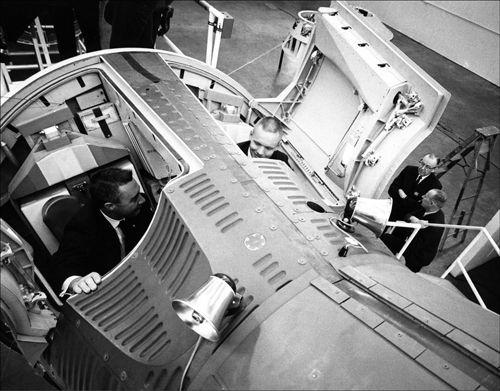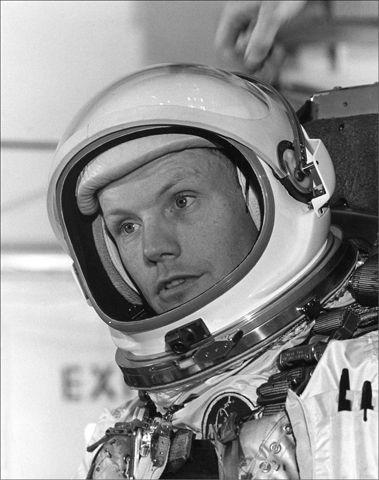Neil Armstrong: A Life of Flight (15 page)
Read Neil Armstrong: A Life of Flight Online
Authors: Jay Barbree
Tags: #Science, #Astronomy, #Biography & Autobiography, #Science & Technology

White was assigned the right seat of
Gemini 4
. Jim McDivitt in command would fly the left. In two or three months they were to follow
Gemini 3
into orbit. Their flight plan called for them to pressurize their spacesuits and then depressurize
Gemini 4
. They would then open Ed White’s hatch and he would stand up. This would expose most of his body and suit to space. That was to have been NASA’s first step at mastering Extra Vehicular Activity.
Neil’s best guess was that with the Russians beating them to the first EVA, NASA bosses would have Ed make a full spacewalk. Neil was aware of Chief Flight Director Chris Kraft’s candor when he complimented the Russians, admitting to the public that the Extra Vehicular Activity “was a tremendous surprise.” Neil knew the Russians clear warning to their cosmonauts that they were headed for the moon was well noted by his agency. He could visualize flight planners laying out a full EVA for Ed but he also knew he would not learn the real details until he was home and talking with Ed over their shared fence.
* * *
Within NASA there might have been even more concern about Russia reaching the moon had they known the details of their plans for cosmonauts Pavel Belyayev and Alexei Leonov—the crew that had just conducted the first EVA.
Soon after the cosmonauts return, mission commander Pavel Belyayev began training for a circumlunar flight, a loop around the moon, which would be made in about two-and-a-half years. Spacewalker Alexei Leonov was assigned to the group training to go to the moon and possibly land. In fact Leonov would become the commander of the Soviets’ lunar-landing program and be promoted to the rank of general. He and cosmonaut Oleg Makarov were planning to follow Belyayev in Zond, a larger spacecraft currently being built. It would be the first two-man circumlunar flight.
The Russians were most aware of the propaganda value of flying around the lunar landscape first even if they couldn’t land. They knew that if Belyayev could complete a flight sooner by doing it alone, then they could lay claim to and no doubt be given full credit for having reached the moon first.
The Soviets settled in with plans to one-up the Americans again as NASA moved through the countdown for its first Gemini. Neil waited in his Hawaiian CapCom chair. He wanted to be ready to help Gus and John when they came his way.
Gemini 3
’s countdown followed its script. The new spacecraft raced into orbit and began the first of three scheduled trips around Earth. The flight plan called for the crew to wring out the all new two-seater—shakedown all its systems. Gus and John did just that. They tested every one of Gemini’s working parts including firing the first-ever group of onboard rocket thrusters. That changed their orbit. They flew maneuvers essential for going to the moon, for rendezvous, and for docking. They quickly came to the conclusion that flying the new two-seater was a delight.
Then, when Gus and John reached Hawaii, they heard a friendly voice. “Molly Brown, this is Hawaii CapCom.”
Commander Gus Grissom had changed
Gemini 3
’s name to the Unsinkable Molly Brown after his first spacecraft
Liberty Bell 7
sank. He wasn’t about to have a repeat on this mission. He cleared his throat and fired back, “Hello, Hawaii, this is Molly Brown, and Neil you’re not going to believe how this baby handles. It flies just right.”
“That’s great, Gus. I can’t wait until I get my turn,” he said, before going into all the numbers and fuel levels they needed to keep their flight going. Then Neil told them, “Everything looks good on the ground. We’ll see you next time around. Aloha.”
“Aloha, Neil.” Gus waved and
Gemini 3
swept across the Pacific, heading for its pass over the 48 contiguous states.
Gemini 3
’s maneuvers were bringing the moon just a bit closer, and when Gus and John reached Hawaii again, they would execute a final test-firing of their new spacecraft’s rockets before setting up for reentry and splashdown.
But first
Gemini 3
had to complete its last trip around Earth. It raced across the other side of the world, down below sweeping over Australia before beginning its climb across the Pacific, taking dead aim for its final Hawaiian pass. Gus and John smiled when they heard the crackle of an incoming transmission. “Hello, Molly Brown. Hawaii CapCom.”
“Hawaii, Molly Brown. All ready to burn,” Gus told Neil, meaning the final firing of their maneuvering rockets was ready.
“Roger,” Neil acknowledged. “We’re right on. Hawaii has radar contact. Give us a start when you burn.”
“Getting ready to fire,” Gus came back. “Mark.”
“We’ve got your start of the burn,” Neil told him.
“That’s good,” Gus said, reporting, “There’s 90, 70, 60, 50, 40, that’s 20—10 percent to go.”

Gus Grissom and Neil Armstrong logging time in the Gemini simulator. (NASA)
“Hawaii command carrier off.”
“Mark,” Gus shouted. “End of burn.”
“Good show,” Neil shouted. “You looked good on the ground,” he added quickly as Gus and John flew away and headed for a perfect reentry and landing.
* * *
With the success of Gemini’s maiden launch, NASA tightened its schedule and kicked Project Gemini into high gear.
Deke Slayton told
Gemini 4
commander Jim McDivitt his crewmate Ed White would perform America’s first full EVA. Ed and Jim went off with the experts and developed a plan.
Six weeks later,
Gemini 4
, the new Houston Mission Control Center’s first flight, roared into orbit. On its fourth trip around Earth, Ed White opened his hatch and stepped out into his own orbit.
Neil, back in Houston, didn’t want to miss a single second of Ed White and Jim McDivitt’s four days in space. He didn’t. He could see easily what was happening when Ed stepped outside over the blue Pacific gripping a handheld gun armed with pressurized oxygen. It fired in timed spurts; a steering jet that pushed him in the direction he sought and stopped his movement when needed.
Neil immediately knew the fun Ed was having and he couldn’t get over the incredible view beneath his spacewalking friend.

Ed White appears to float on a mattress of puffy clouds. (NASA)
Ed White was beginning to understand his inability to move his own body when suddenly he was startled. The strangest satellite yet launched floated before him. It was a thermal glove he had left on his seat. It drifted up and away and began its own orbit, and Ed scolded himself with one word: “careless.”
Then, not at all aware the twelve minutes planned for his outside adventure had quickly passed, it was time to reenter
Gemini 4
. He was running out of daylight, but he was having too much fun.
Gus Grissom was CapCom in the new Mission Control Center 27 miles southeast of Houston, and he knew the euphoria White was showing was akin to the dangerous “raptures of the deep.”
Grissom, in the veteran Mercury astronaut’s deep command voice, told the frolicking spacewalker, “
Gemini 4
, get back in.” Neither Grissom nor White was aware of how their fates were so intertwined.
Ed White’s crewmate and commander Jim McDivitt repeated the order: “They want you to get back in now.”
The fun-loving spacewalker still hesitated. “What does the flight director say?” he asked.
“The flight director says get back in,” barked Chris Kraft.
“This is fun! I don’t want to come back in,” White laughed, performing one more somersault before telling Mission Control, “Okay, I’m coming in.”
Ed reluctantly began his return to
Gemini 4
but quickly discovered just to move his body even one inch from its independent orbit without help wasn’t at all easy. He needed an assist. He needed a jet backpack or a line to pull. Otherwise he’d simply drain his energy and his body would begin to overheat.
Ed White made it back in but he’d just discovered a major difficulty that would confound future spacewalkers.
* * *
Gemini 4
returned after four days of orbiting Earth, and that August,
Gemini 5
, with Gordon Cooper and Pete Conrad, doubled
4
’s record by spending eight days in space. Their backups Neil Armstrong and Elliot See were at the Cape for
5
’s launch, and immediately left for a quick flight in their T-38 to Houston’s Mission Control.
Armstrong and See spent
Gemini 5
’s eight days in Mission Control in the comfort of air-conditioning, hot food, and ready refreshments while Cooper and Conrad spent those same eight days inside their slightly-larger-than-a-phone-booth spacecraft. They proved humans could function long enough in space to fly to the moon and back, and when the
Gemini 5
astronauts returned, newspapers ran a cartoon of them holding hands on the recovery ship’s deck with the caption: “We’re engaged.”
Gemini 5
was one of those fun flights and three weeks after its splashdown Deke Slayton made it official: He cornered Neil Armstrong and told him he would command
Gemini 8
.
Neil nodded, smiling.
Deke then told him his crew member would be Dave Scott, a West Point graduate and the first member of the third group of astronauts to fly.
Deke got no argument from Neil as the next group of astronauts, a small assemblage of six scientists, were named; Owen Garriott, Edward Gibson, Duane Graveline, Joseph Kerwin, Curt Michel, and Harrison Schmitt. Schmitt would become the only scientist to reach the moon.
* * *
Astronauts Frank Borman and James Lovell bettered
Gemini 5
’s record by spending two weeks inside
Gemini 7
’s cramped quarters, and Lovell would later say, “It was like spending two weeks in a men’s room.”
The monotony of Borman and Lovell’s marathon mission was broken on day eleven by visitors from Earth.
Wally Schirra and Tom Stafford were flying
Gemini 6
. They rode their two-seater right up to
Gemini 7
and put on the brakes. They thought they would stay for a while and Schirra and Stafford began “station keeping” with Borman and Lovell. It was the first rendezvous in space.

Gemini 6
and
Gemini 7
meet in space. (NASA)
“We’ve got company,” Lovell reported.
“There’s a lot of traffic up here,” Schirra quipped.
“Call a traffic cop,” Borman laughed.
American astronauts had used the Gemini spacecraft’s rockets to perform a meaningful first and the two Gemini ships together orbited Earth in formation, doing fly-arounds and circling each other in a series of figure eights. Wally Schirra told Mission Control he closed to a distance of six to eight inches, backed off, and flew in again.
Schirra was the only member of the Mercury Seven “pranksters” in the group, and when he flew his
Gemini 6
away from
Gemini 7
, he and Tom Stafford shook up Mission Control when Stafford reported he had seen a UFO.

